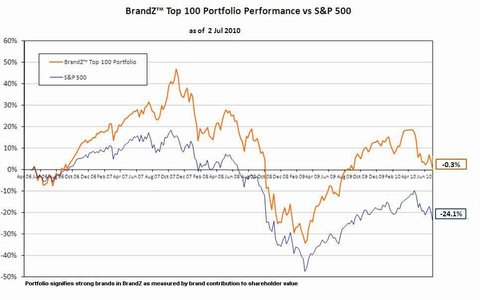The successful creation and management of brands will be the hallmark of business leadership in the 21st century. Does that sound bold? Perhaps, but the world today is far different from what it was only a couple of decades ago and these structural changes have placed brands at the forefront of business success. A review of stocks in the S&P index shows that businesses that own stronger brands perform significantly better than businesses that own weaker brands.
Business leadership and brand leadership have become inextricably linked.
According to Millward Brown Optimor’s analysis, in 1980 virtually the entire value of an average S&P 500 company was comprised of tangible assets (chairs, factories, inventory, etetera). In 2010, tangible assets account for only 30 to 40 percent of a company’s value. The rest is intangible value, and about half of that intangible portion, close to 30 percent of total business value, is attributed to brands. Therefore it is not a stretch to say that for many companies, brand is their single biggest asset. What has led to this change in what matters to business success?
Why is brand driving business leadership – the Post-Information Era
The technological advances of the 20th century generated more prosperity than ever existed before. Consumers in developed markets came to have almost limitless choices in almost every category. What is more, as companies innovated into new spaces, there are now many new categories to choose from.
Abundance and prosperity have allowed companies to redefine what consumers “need.” Yet wealth hasn’t necessarily made us much happier. As Daniel Pink writes in A Whole New Mind, “The paradox of prosperity is that while living standards have risen steadily decade after decade, personal, family and life satisfaction haven’t budged. That’s why more people – liberated by prosperity but not fulfilled by it – are resolving the paradox by searching for meaning.” This quest for meaning has huge implications for brands. As people find their basic consumption needs satisfied, brands are uniquely positioned to help add a higher order of meaning and fulfillment to purchase decisions, and consumers’ lives.
What used to be sufficient for a company’s success – an excellent product and superior execution of service delivery – are now merely table stakes. The emergence of higher meaning, or purpose, as a critical consumer decision factor, represents a unique opportunity for companies willing to reinvent themselves through, and invest in, their brands. Brands, unlike products, are impossible to imitate. In fact, by one definition, a brand is the unique place occupied in the customer’s mind by a product or service. Therefore, if a brand is able to create a strong connection with its customer base, it has created the ultimate source of differentiation and therefore competitive advantage. Visionary business leaders have anticipated this and have carefully invested in their brands, making them the cornerstone of their business strategy. It is not necessarily the amount of investment behind the brand that has made the difference, but the fundamental principles these leaders have followed. This gives rise to the question: how have brands driven business success?
How is brand driving business leadership – the rise of brand purpose
Earlier we explored how prosperity has prompted people’s search for meaning beyond basic need on a mass scale. Brands have the unique ability to tap into this pursuit for meaning, because both brand and meaning are intangibles. Both operate on the same plane of human existence and consciousness. Which brands will therefore be most successful at connecting with their customers? A simple look at the brands that have created the most value over time can provide clues to the answer.
According to the BrandZ Top 100 Most Powerful Brands study published annually in the Financial Times, the three largest brands today are Google, IBM and Apple. What do they have in common? Although all three can be generally described as “technology” companies, their business models, their products, and their customers are wildly different. Yet, all three are at the top of the list. I argue that what sets these brands apart from their many competitors is an orientation towards a brand ideal, a brand purpose. Google, since its inception, has single-mindedly focused on the ideal of liberating people through the universal availability of information. IBM has taken on helping create a “smarter planet,” and Apple invites people to create their world through self-expression; to “think different.”
Therefore, the brands that have created the largest connection with their audiences (and the largest values for their companies) are those that stand for true ideals, because true ideals directly tap into people’s quest for meaning.
Jim Stengel, former global marketing officer of Procter & Gamble and arguably today’s most influential marketer, is propagating the movement of Brand Ideal as the way to explain brands’ role in driving business leadership. He identifies the conceptual elements of the brand ideal, noting, “The Ideal is a higher order benefit that a brand gives to the world… The ideal actively improves the quality of people’s lives.”
To create a brand ideal a company must identify a higher calling than simply selling its product. This ideal drives innovation and inspiration, enhances recognition and unifies the organization in delivering against it. It does not only inform business strategy; in a very essential way it is the business strategy.
Brand ideals are not proprietary to large brands. A personal favorite of mine due to its authentic application of a brand ideal is Method. Method surprised consumers by bringing design and emotion into the mundane category of home cleaning products. Its brand ideal, to inspire a healthy happy home created the aspirational lifestyle of a ‘Method home.’ Method built a culture that reflects its values – ‘People against Dirty’ – and engaged its advocates in exciting and inclusive ways. The result has been astonishing growth in a very short time.
Indeed, brand ideals executed authentically drive business success. A shocking 87 percent of consumers say they are likely to switch to a brand that is associated with a higher purpose. While many companies have focused on cause-marketing or corporate social responsibility (CSR), humanitarian goals are neither a prerequisite nor sufficient conditions for a brand to have an ideal. The ideal needs to serve and make reference to universal human truth, but that truth does not have to be always connected to a social value.
For example, Red Bull has developed a $4.4 billion business based on a brand ideal that does not have a humanitarian bent. Red Bull created a category by serving the individual ideal of energy and freedom and by empowering people to lift their body and spirit. Red Bull’s example also illustrates how a brand ideal differs from CSR and cause-marketing. Energy and freedom is not a “project” that the brand undertook. It is not a marketing initiative to fulfill the company’s responsibility to society. Red Bull’s brand ideal is what the company does. From the way its offices are designed – with ramps so employees can skateboard from floor to floor – to the kinds of people it hires to every participatory event it organizes – such as the Red Bull Air Race World Championship and the Red Bull Storm Chase – to every piece of communication it transmits, the brand “gives you wings.”
The ultimate test of the brand ideal’s authenticity lies in the degree to which it permeates the business and provides a compass for everything the company does. The brand ideal is first and foremost an internal organizing principle. This has a tremendous impact on alignment and on employee behavior, satisfaction and retention. This in turn allows the brand to show up in the world with an intentionality and purpose that is instantly transmitted to customers. Starbucks was such a brand a few years ago. Despite virtually no advertising communication investment the brand through the choices and behaviors of its employees created a customer experience and a “third place” between the home and the workplace where people could create human connections.
So is the importance of brand and brand ideals a permanent structural shift in the way we conduct our economic lives, or is it a transitory phenomenon? The answer to this question can be found in the very roots of this shift from product to purpose. As long as global output expands through technological advances and as long as prosperity reaches a larger number of consumers, brands and brand ideals will not only drive business success but their importance will continue to increase. The businesses therefore that will make it their priority to organize around a higher purpose are and will continue to be the leaders of the 21st century.
The Blake Project Can Help: Please email us for more about our purpose, mission, vision and values and brand culture workshops.
Branding Strategy Insider is a service of The Blake Project: A strategic brand consultancy specializing in Brand Research, Brand Strategy, Brand Licensing and Brand Education






2 comments
Hans van den Berg
November 24, 2010 at 1:41 pm
Mario, great article! When we look at all brand rankings consolidated together indeed the brands that you mention arrive also very high in the top. I hope soon some brands of smaller companies get more visibility in brand rankings globally.
Dan T.
November 29, 2010 at 5:14 pm
I certainly agree with the ever increasing importance of the brand itself and the continued shift towards brand management. However, the brand, company, products and services have to to reflect the true image of the entity itself. You have to truly represent what you tout in your brand and work at it relentlessly or customers will champion those that do. The leadership has to stay intact internally to be able to lead the brand to new heights.
Comments are closed.